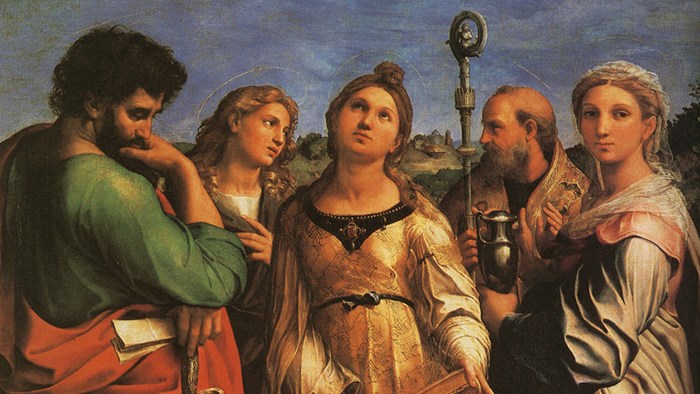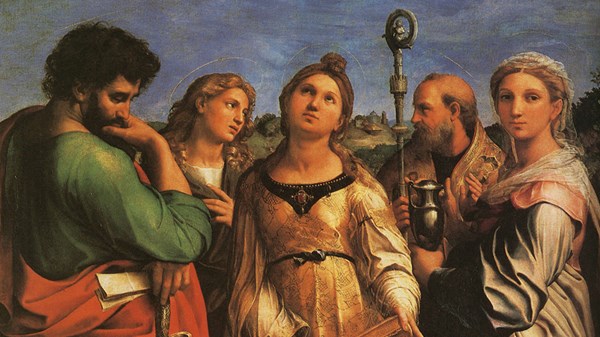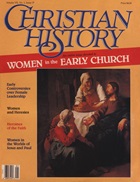
Women were the last disciples at the cross and the first at the empty tomb. They remained integral to the work of the church in its early centuries. Catherine Kroeger scours historical data to compile an impressive collection of stories about noteworthy women in the early church.
One of the best-kept secrets in Christianity is the enormous role that women played in the early church.
Though they leave much unsaid, still, both Christian and secular writers of the time attest many times to the significant involvement of women in the early growth of Christianity.
Celsus, a 2nd-century detractor of the faith, once taunted that the church attracted only “the silly and the mean and the stupid, with women and children.” His contemporary, Bishop Cyprian of Carthage, acknowledged in his Testimonia that “Christian maidens were very numerous” and that it was difficult to find Christian husbands for all of them. These comments give us a picture of a church disproportionately populated by women.
Why? One reason might have been the practice of exposing unwanted female infants—abandoning them to certain death. Christians, of course, repudiated this practice, and thus had more living females.
Also, in the upper echelons of society, women often converted to Christianity while their male relatives remained pagans, lest they lose their senatorial status. This too contributed to the inordinate number of women in the church, particularly upper-class women. Callistus, bishop of Rome c. 220, attempted to resolve the marriage problem by giving women of the senatorial class an ecclesiastical sanction to marry slaves or freedmen—even though Roman law prohibited this.
These high-born Christian women seized upon the study of the Bible and of Hebrew and Greek. The circle of Roman women who studied with Jerome in the late 300s showed such scholarship that he thought nothing of referring some church elders to Marcella for the resolution of a hermeneutical problem. By the early 400s, Augustine could declare that “any old Christian woman” was better educated in spiritual matters than many a philosopher.
The women’s spiritual zeal exploded into social service. Fabiola founded the first Christian hospital in Europe. Many other church women encountered severe opposition from their families for spending their wealth so generously in helping the poor. Such selfless ministry became a trademark of Christian women.
In a letter to his wife, Tertullian gives us a glimpse into some of the ministries of church women in his time. He charges her, in case of his own death, to not marry a pagan.
“Who would be willing to let his wife go through one street after another to other men’s houses, and indeed to the poorer cottages, in order to visit the brethren? Who would like to see her being taken from his side by some duty of attending a nocturnal gathering? At Easter time who will quietly tolerate her absence all the night? Who will unsuspiciously let her go to the Lord’s Supper, that feast upon which they heap such calumnies? Who will let her creep into jail to kiss the martyr’s chains? Or bring water for the saints’ feet?”
Women As Witnesses of Jesus
It is no surprise that women were active in the early church. From the very start—the birth, ministry, death and resurrection of Jesus—women were significantly involved. In fact, women were the major witnesses of his crucifixion and resurrection. Matthew, Mark and Luke all record that a significant group of women had followed Jesus in his Galilean ministry, and that they were present at his execution—when the male disciples were conspicuously absent.
All three describe the women’s presence at Jesus’ burial. Luke declares that the women who had followed Jesus from Galilee still followed along as Christ was carried to the tomb. Mark details the care with which Mary Magdalene and Mary the mother of Joses noted where He was laid, while Matthew tells how they kept watch over the sepulchre after the men had left. John tells of the group immediately beneath the cross, three women and one man. John alone preserves the garden interview between Mary Magdalene and the Risen Christ.
The proclamation of the astounding Easter event was entrusted to these women. The angel reminded them that they had already been instructed by Jesus about His death, burial and resurrection. The women remembered and hurried off to tell the men. Their witness remains an integral part of the gospel to this day. The early church considered Mary Magdalene an “apostle to the apostles,” and Luke relied heavily on the testimony of women as he wrote both Luke and Acts.
The involvement of women continued in the first few decades of the church, attested by both biblical and extra-biblical sources. A number of women served as leaders of the house churches that sprang up in the cities of the Roman Empire—the list includes Priscilla, Chloe, Lydia, Apphia, Nympha, the mother of John Mark, and possibly the “elect lady” of John’s second epistle.
In the 2nd century, Clement of Alexandria wrote that the apostles were accompanied on their missionary journeys by women who were not marriage partners, but colleagues, “that they might be their fellow-ministers in dealing with housewives. It was through them that the Lord’s teaching penetrated also the women’s quarters without any scandal being aroused. We also know the directions about women deacons which are given by the noble Paul in his letter to Timothy.”
Was that perhaps the role of Junia? She was mentioned by Paul in Romans 16 as “of note among the apostles.” Some have debated the meaning of this verse, but early tradition holds that Junia was a woman and was considered an apostle. John Chrysostom wrote: “Indeed, to be an apostle at all is a great thing; but to be even amongst those of note; just consider what a great encomium that is … Oh, how great is the devotion of this woman, that she should even be counted worthy of the appellation of apostle.”
Until the Middle Ages, the identity of Junia as a female apostle was unquestioned. Later translators attempted to change the gender by changing the name to the masculine Junias. But such a name is unknown in antiquity; and there is absolutely no literary, epigraphical or papyrological evidence for it.
Paul also mentions Phoebe in Romans 16, “a deacon of the church at Cenchreae.” He calls her a prostatis or overseer. This term in its masculine form, prostates, was used later by the Apostolic Fathers to designate the one presiding over the Eucharist. And Paul uses the same verb, the passive of ginomai (to be or become), as he uses in Colossians 1:23: “I was made a minister.” In the passive, the verb sometimes indicated ordination or appointment to an office. Thus one might legitimately translate Paul’s statement about Phoebe: “For she has been appointed, actually by my own action, an officer presiding over many.” The church in Rome is asked to welcome her and assist her in the church’s business.
The four daughters of Philip appear in Acts 21:9 as prophetesses. Eusebius viewed these daughters as “belonging to the first stage of apostolic succession.”
Another prophetess attested to by extra-biblical tradition is Ammia, who prophesied in Philadelphia during New Testament times, and was received with reverence throughout Asia Minor. The first preserved mention of her dates to about 160 A.D.
2nd-Century Church Women
Just as the letters of Paul abound in references to his female associates in ministry, the Apostolic Fathers also mention women as stalwarts in the faith. Twice Ignatius sent greetings to Alce, whom he calls especially dear to him. He also greeted Tavia and her household; perhaps she was another house-church leader.
Polycarp mentioned the sister of Crescens, who deserved special commendation when she and her brother arrived in Philippi to deliver the letter. The Shepherd of Hermas, written about 148 A.D., gives instructions that two copies should be made of the work and one given to Grapte, “who shall exhort the widows and orphans.” The other copy was to be given to Bishop Clement to share with the elders. It appears that Grapte and Clement represented the female and male leaders respectively.
But Christians were not the only ones prompted to write about the female followers of Jesus. About 112 A.D., the Roman governor Pliny the Younger detailed his efforts to cope with the nascent church in Bithynia. He had found it necessary to interrogate the leaders, two slave women called ministrae, or deacons. These women apparently followed in the tradition of Phoebe.
Spurious Works
Certain female leaders are described as fully historic personages, while others are embedded in legend. Catherine of Alexandria, for instance, reportedly lived in the 2nd century, though the earliest reference to her is in an 8th-century work. The patron saint of scholars and philosophers, she allegedly debated 50 philosophers and won them all to Christ. As a result, she was condemned to death and ultimately perished on the wheel (hence the name of the “Catherine wheel,” a rotating firework).
Her story may have been drawn from that of Hypatia, the noted pagan philosopher also of Alexandria, also of the 2nd century. Hypatia did in fact meet her death at the hands of an enraged Christian mob, and her historicity is beyond doubt. The Catherine story may well be drawn from that of Hypatia, but it demonstrates a willingness in the church to project a woman as a spiritual and intellectual leader.
Spurious works, even if their authorship is in doubt, can still have value in demonstrating certain attitudes. Two epistles erroneously attributed to Ignatius preserve an appeal from Mary of Cassobelae that three members of the clergy, Maris, Eulogius and Sobelus, be appointed to serve in her community so that it might not be devoid of those fit to preside over the Word of God. She begs Ignatius to not deny her request simply because the three are young and two of them newly ordained. Rather, she argues from the Scriptures that youth is no deterrent to a significant ministry for God. Pseudo-Ignatius replies: “Thy intelligence invites us, as by a word of command, to participate in those divine draughts which gush forth so abundantly in thy soul … Thy numerous quotations of Scripture passages exceedingly delighted me, which, when I had read, I had no longer a single doubtful thought respecting the matter… Thou art perfect in every good work and word, and able also to exhort others in Christ.”
He promises to comply with her wishes, citing the fame which had accrued to her earnest dedication to Christ at the time of her visit to Rome during the bishopric of Linus (beginning of the 2nd century). The letter is probably no earlier than the 4th century, but it demonstrates an attitude that was able to gain currency in the early church. A woman of outstanding spiritual gifts purportedly gives direction in the appointment of clergy, and is applauded for the inspiration she affords. The personages may be fictitious, but the appreciation of feminine spirituality is real.
The Legend of St. Thecla
The legend of St. Thecla has endeared itself to modern women as well as to their earlier counterparts. It is the bestknown of the numerous apocryphal stories of early Christian heroines. According to the 3rd- century text of The Acts of Paul, Thecla, a noblewoman, was converted while listening to the preaching of the apostle. Forsaking her old life, she followed Paul and endured persecution, tribulation and great peril. The story resembles the ancient pagan romances in the repetition of hair’s-breadth escapes, the fortitude and nobility displayed by both hero and heroine, and the happy ending. It is, however, a Christianized romance, as are several other of the apocryphal Acts and The Recognitions of Peter.
Thecla appears as a truly heroic character who endures all manner of suffering for the sake of Christ. After her itineration through Asia Minor with the Apostle Paul, she settles near Seleucia, where she teaches, preaches, heals and baptizes. Tertullian, incensed that Montanist women used her as a model, declared that a deacon had confessed that he fabricated the story “for love of Paul.” William M. Ramsay maintained that The Acts of Paul contained an authentic 1stcentury account, which had been outrageously embellished by the 3rd-century deacon. Dennis McDonald has pointed out that, though the story is almost surely fictitious, this does not obviate the existence of an actual female leader of that name.
Both Gregory of Nazianzus and Basil of Caesarea spoke of Thecla as a historical figure. Writing in the 300s, they described her teaching center and hospital near Seleucia. The pilgrim Egeria visited this facility in 399 A.D., and also described its monasteries, convents and assembly buildings, along with the teaching and healing ministries that went on there. The German team that excavated the center in 1908 found the apse still standing above the ground, with the main basilica’s outlines covering a space equal to that of a football field. The excavators also found numerous cisterns, apparently for washing the sick, two other churches, and many fine mosaics. The center apparently was in active use for at least 1,000 years, indicating the presence in Asia Minor of an extremely strong female leader.
Women in Consecrated Orders
Beside the outstanding achievements of individual women stood the ministry of consecrated women in specialized orders. These orders included ecclesial widows, virgins, presbyteresses and deaconesses. Sometimes such women were formally ordained and sat with the rest of the clergy in front of the congregation.
Mary McKenna suggests that the disadvantaged women who accompanied Jesus in his Galilean ministry (Luke 8:23) formed the beginning of the order of widows. The Greek term cheira might refer to any woman who found herself in difficult circumstances. Tertullian complained of a virgin who was admitted to the order of widows at the age of 19! These widows were supported by the gifts of the congregation, and in turn were expected to pray for their benefactors as well as for all other members of the church. Their duties and qualifications were developed from the instructions in 1 Timothy 5. In the Clementine Recognitions and Homilies, perhaps from the first half of the 3rd century, St. Peter, as he prepares to leave Tripoli, appoints elders and deacons and organizes an order of widows.
The widow came to be looked upon as “the altar of God,” both because of her ministry of intercession and because of the gifts that she received. Under no circumstances should she reveal the name of a donor, lest other widows demand an equal gift from the same source or, worse yet, curse the one who withheld such benefices. The Didascalia insisted that neither “the bishop nor a presbyter, nor a deacon, nor a widow should utter a curse,” because widows “had been appointed to bless.”
Widows were clearly part of the ordained clergy in the Testament of Our Lord Jesus Christ, a 5th-century reworking of earlier material from Hippolytus’s Apostolic Tradition. The selection process and ordination service of widows parallels those of deacons, bishops and presbyters. The document applies the title “presbyteresses” to these women, and six times refers to them as “the widows who sit in front.” During communion, they stood by the altar, close to the bishops, presbyters and deacons, and within the veil that screened off the laity. These widows assumed pastoral responsibilities such as instructing female catechumens and the ignorant, gathering those who desired to live a pure life for prayer and encouragement, rebuking the wayward, and seeking to restore them.
Women As Deacons
As Clement of Alexandria made mention of Paul’s reference to deaconesses in 1 Timothy 3:11, so Origen commented on Phoebe, the deacon that Paul mentions in Romans 16:1–2:
“This text teaches with the authority of the Apostle that even women are instituted deacons in the Church. This is the function which was exercised in the church of Cenchreae by Phoebe, who was the object of high praise and recommendation by Paul… And thus this text teaches at the same time two things: that there are, as we have already said, women deacons in the Church, and that women, who by their good works deserve to be praised by the Apostle, ought to be accepted in the diaconate.”
Women deacons appear to be under discussion in 1 Timothy 3:11, although the feminine form “deaconess” did not come into use until about 100 A.D. As late as the end of the 4th century, diaconos might designate a woman as well as a man. The order of deaconesses as distinct from that of widows appears clearly delineated in the first half of the 3rd century in the Didascalia, which declared that the deaconesses should be honored as figures of the Holy Spirit. They could visit believing women in pagan households where a male deacon would be unacceptable. To them belonged the duties of visiting the sick, bathing those recovering from illness, and ministering to the needy. Deaconesses also assisted in the baptism of women, anointing them with oil and giving them instruction in purity and holiness. They could give communion to women who were sick and unable to meet with the entire church. The Apostolic Constitutions even specified that both male and female deacons might be sent with messages outside the city limits. The ministry of the widow was largely that of prayer, fasting, and laying of hands on the sick, while the deaconess, usually a considerably younger woman, undertook the more physically arduous tasks.
Ancient documents show that deaconesses were ordained. The Council of Chalcedon set down requirements for the ordination of deaconesses, and the Apostolic Constitutions includes their ordination prayer.
Women As Elders
The feminine form of “presbyter” or elder occurs frequently, though it is often translated simply as “old woman.” At times the term certainly refers to women who were part of the clergy. The Cappadocian father, Basil, uses presbytera apparently in the sense of a woman who is head of a religious community. Also applied to women is the term presbutis, “older woman” or “eldress.” The old woman who instructed Hermas is called presbytis. It occurs not only in Titus 2:3, but most markedly in Canon 11 of Laodicea, which forbade the appointment of presbytides (eldresses) or of female presidents (prokathemenai).
The masculine form, prokathemenos, indicated the presbyter or bishop who presided over the communion service. Dionysius of Alexandria, who died in 264 A.D., described a martyr as “the most holy eldress Mercuria” and another as “a most remarkable virgin eldress Apollonia.” A variant reading of the apocryphal Martyrdom of Matthew, a 4th- or 5th-century document, tells how Matthew ordained a king as priest and his wife as presbytis, “eldress.” Epiphanius and Theodoret vehemently repudiated any priestly function accruing to the “presbytides.”
Women As Priests?
There are even a few scattered references connecting women to the priesthood. Pseudo-Ignatius’s Letter to the Tarsians commands that those who continue in virginity be honored as priestesses of Christ. The eldresses of Titus 2:3 must be “hieroprepeis,” a term that inscriptional evidence suggests should be translated “like a priestess,” or “like those employed in sacred service.” The Cappadocian Gregory of Nazianzus wrote to Gregory of Nyssa about Theosebia, “the pride of the church, the ornament of Christ, the finest of our generation, the free speech of women, Theosebia, the most illustrious among the brethren, outstanding in beauty of soul. Theosebia, truly a priestly personage, the colleague of a priest, equally honored and worthy of the great sacraments.”
The walls of the Roman catacombs bear pictures showing women in authoritative stances, with their hands raised in the posture of a bishop. The Ecclesiastical Canons of the Apostles specifically forbade women to stand in prayer (24:1–8). But here we see them standing in prayer, exercising a ministry of intercession and benediction, and dominating the scene. To this day, their steadfast faith and ministry still bless us.
Dr. Catherine Kroeger is chaplain and lecturer in the department of religion at Hamilton College in New Hartford, N.Y. Her doctorate is in classical studies and Greek, with a specialization in women in ancient religion, especially women and the ecclesiology of the Apostle Paul
Copyright © 1988 by the author or Christianity Today/Christian History magazine.
Click here for reprint information on Christian History.

Support Our Work
Subscribe to CT for less than $4.25/month






























